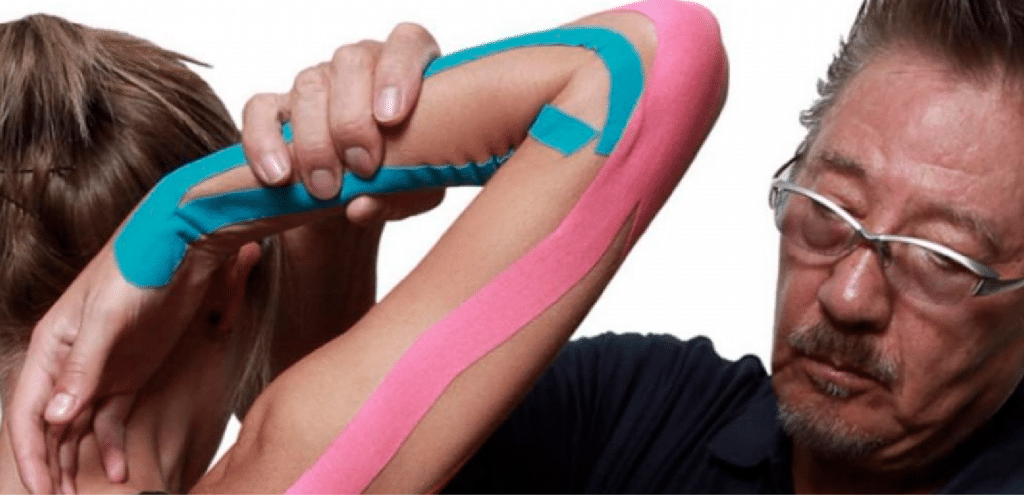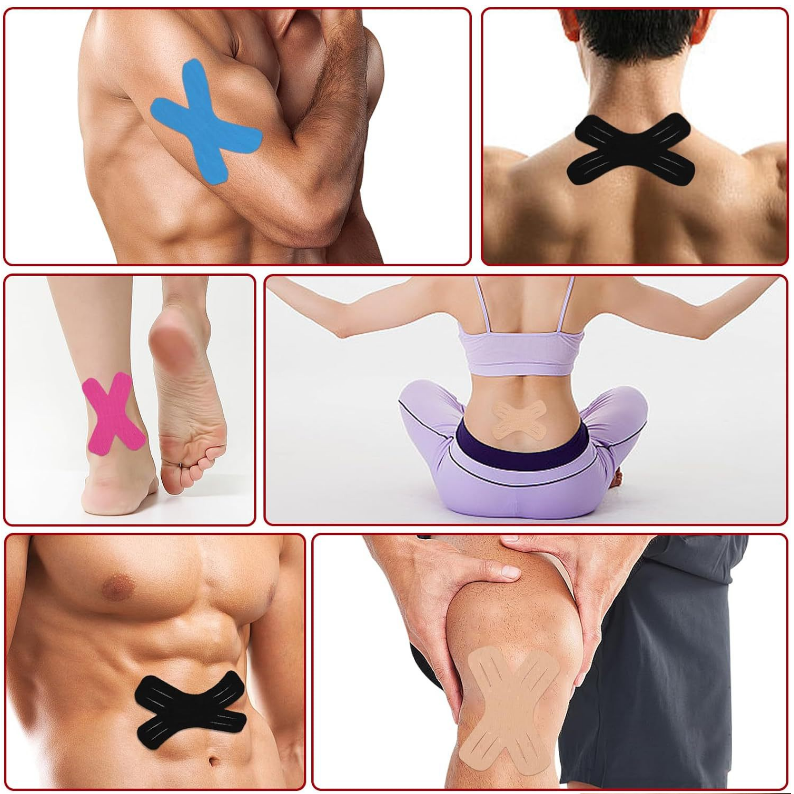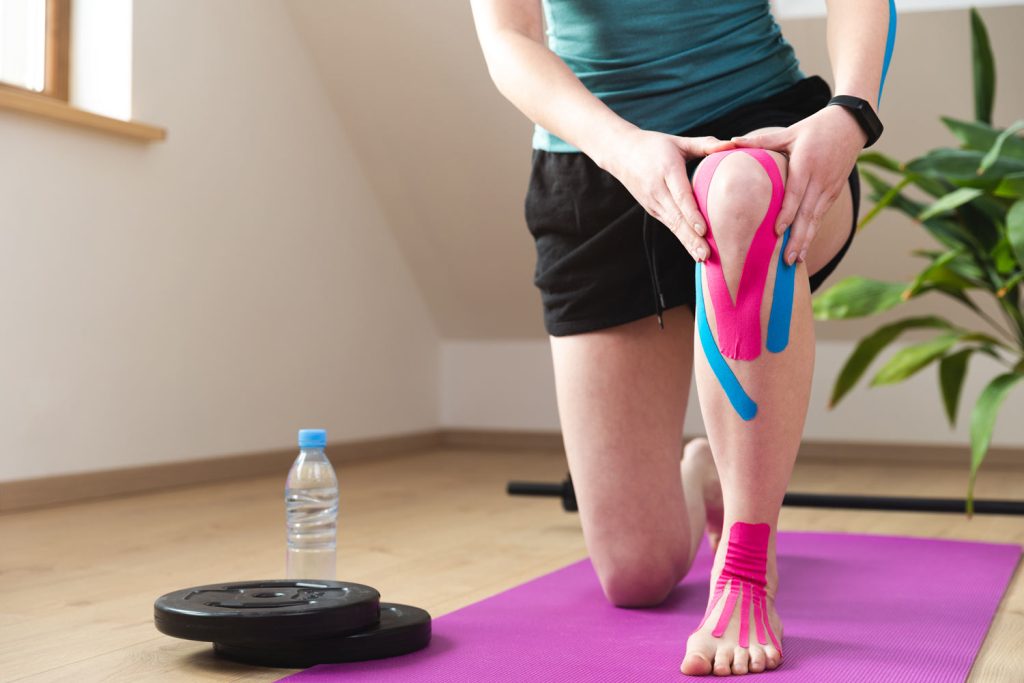Introducing Kinesiology Tape
what is kinesiology tape made of?
Kinesiology tape is a therapeutic tool made from a blend of cotton and nylon, designed to mimic the skin’s elasticity. This unique composition allows the tape to stretch up to 140% of its original length, making it highly versatile for various therapeutic uses. The tape’s adhesive is heat-activated, enabling it to adhere securely to the skin during rigorous activities and even through multiple showers.
When was kinesiology tape invented?
The use of kinesiology tape originated in the 1970s when Japanese chiropractor Dr. Kenzo Kase developed a tape that would provide support without the bulk and restrictive properties of traditional athletic tape. Dr. Kase’s intention was to create a tape that could assist in the healing of injured muscles and joints while supporting muscles and joints during activity without restricting the range of motion. This led to the development of a tape that could be used not only by athletes but also by individuals suffering from a variety of musculoskeletal and inflammatory conditions.

Dr Kenzo Kase applying kinesiology tape
Benefits of Using Kinesiology Tape
Kinesiology Tape Can Enhance Muscle Support and Joint Stability
Kinesiology tape is beneficial for athletes who require full mobility and also for those recovering from injuries. The tape’s elastic properties allow for a gentle lifting of the skin, creating a small space between the muscle and dermis. This space decreases the likelihood of compression of the muscle, enhances blood and lymphatic flow which aids in faster recovery from muscle fatigue and joint injuries.
Kinesiology Tape Reduces Pain and Stimulates Sensory
By lifting the skin, kinesiology tape promotes decreased inflammation and stimulates sensory neurons in the skin, which reduces the perception of pain. This phenomenon is known under the “gate control theory” of pain. The tape’s pressure on the skin helps to modulate pain signals sent to the brain, which can provide relief from both acute and chronic pain.
Kinesiology Tape Can Accelerate Recovery from Bruising and Swelling
One of the key benefits of kinesiology tape is its ability to reduce bruising and swelling quickly. The decompression effect created by the tape increases circulation and lymphatic drainage. Enhanced lymphatic drainage removes fluids that accumulate in the tissue after injury or inflammation, speeding up the overall healing process.
Kinesiology Tape Can Improve Posture and Muscle Tone
According to a research published on Chiropractic & Manual Therapies, continuous application of kinesiology tape can help improve posture and assist muscle tone by providing sensory feedback that encourages a better alignment and muscle activation pattern. This can be particularly helpful in conditions like “computer back” or “text neck,” where poor posture is common due to lifestyle habits.

Kinesiology tape can help with posture-related syndromes
To read more details about kinesiology tape vs athletic tape, please read our blogs by clicking the highlighted area.

Kinesiology tape and athletic tape have different focus.
Who Can Use Kinesiology Tape?
Kinesiology Tape for Athletes
Kinesiology tape can benefit athletes. Because it helps with both injury prevention and recovery, kinesiology tape is popular to in professional sports. However, its uses extend far beyond the athletic field.
Chronic Pain and Rehabilitation Patients
People suffering from chronic pain conditions such as arthritis or back pain find relief through the subtle mechanical support and improved circulation that kinesiology tape provides. Additionally, those in rehabilitation from joint surgeries or muscle injuries use the tape to enhance healing and maintain range of motion, which is crucial for recovery.
Special Populations: Pregnancy and Postural Adjustments
Pregnant women benefit from kinesiology tape through applications that support the abdomen, reducing pressure on the back and improving posture. This can alleviate common pregnancy-related pains in the lower back and pelvis. Moreover, individuals with postural issues, often from prolonged desk jobs, use kinesiology tape to encourage proper alignment and reduce strain on affected muscles and joints.

Kinesiology tape can benefit pregnancy by supporting the abdomen
Debunking Myths Around Kinesiology Tape
Myth 1: Kinesiology Tape is Only for Athletes
One common misconception is that kinesiology tape is solely for athletes. While it’s prominently used in sports, its benefits extend to non-athletes, including individuals with chronic pain, those recovering from surgery, and even pregnant women looking for support and pain relief.
Myth 2: Kinesiology Tape Can Fix Anything
Another myth is that kinesiology tape is a cure-all for any injury. While kinesiology tape is effective for support and relief, it is most beneficial when used as part of a comprehensive treatment plan including physical therapy, proper rest, and, when necessary, medical intervention.
Myth 3: The Tape’s Color Affects Its Functionality
There is a playful myth that the color of the kinesiology tape can influence its effectiveness, perhaps inspired by color therapy concepts. However, the color of the tape is purely aesthetic and does not impact its physical properties or therapeutic benefits.
Myth 4: More Tape Equals Better Support
Using excessive amounts of tape does not equate to increased benefits. In fact, improper application or too much tape can restrict movement unnecessarily or lead to discomfort. Correct application is key to maximizing the tape’s effectiveness.

Follow the correct instruction to apply kinesiology tape.
Conclusion
Kinesiology tape has revolutionized the approach to managing pain, supporting mobility, and enhancing performance, both in athletic endeavors and everyday life. Its ability to provide dynamic support, promote better circulation, and aid in recovery makes it a standout choice for anyone looking to improve their physical condition.
At Fonitaniya, we pride ourselves on producing reliable and effective kinesiology tape, backed by years of research and development. From athletes looking to optimize performance to individuals seeking relief from chronic pain, our kinesiology tape offers a non-invasive and empowering solution.
You can see an example of one of our best-seller, the kinesiology tape with X shape.
FAQs
How do you apply kinesiology tape correctly?
Start with clean, dry skin, place an anchor strip, then layer support strips as needed, and secure with a locking strip.
What’s the difference between athletic tape and kinesiology tape?
Athletic tape restricts movement to stabilize joints, while kinesiology tape allows a range of motion and enhances blood flow.
How often should you change kinesiology tape?
Replace athletic tape every one to three days, or sooner if it becomes loose or uncomfortable.
Can kinesiology tape prevent injuries?
Yes, when applied properly, athletic tape can help prevent injuries by stabilizing muscles and joints during physical activity.
Is athletic tape waterproof?
Some athletic tapes are waterproof, allowing them to be worn during sweat-inducing activities or in wet conditions.
How long can you wear athletic tape?
Typically, you should not wear athletic tape for more than three days at a time to avoid skin irritation.
Can you apply kinesiology tape by yourself?
Yes, with practice and proper technique, you can self-apply athletic tape for common injuries like sprains or tendon support.
What should you do if you experience pain or discomfort from athletic tape?
Remove the tape immediately if you experience any pain, discomfort, or skin irritation, and consult a healthcare professional if necessary.


